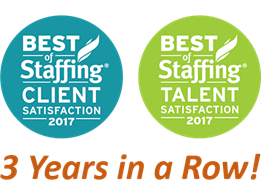
With unemployment rates so low, many employers are asking the same question in the workplace: How do we engage and retain our current employees and help them see a clear path to professional growth within our organization?
The cost of turnover within any organization is high – not just in dollars and cents, but in time and resources. As a nonprofit, your resources are one of your biggest assets and it is especially important to use them wisely and save where you can.
Because we have the opportunity to support and partner with nonprofit organizations on a daily basis, we understand that many employers are looking for answers to this key question. To gain insight into this challenge, we turned to our candidate pool. From January to February 2017, we surveyed candidates in Atlanta, Chicago, and Washington, D.C., collecting 440 responses.
First, we wanted to understand how employees define success in their career development; we asked:
How do you measure your success in your career progression?
- 49.43%: The level of happiness and satisfaction I have within my role.
- 26.42%: The achievement of professional goals I set for myself.
- 9.79%: The promotions and title changes I receive.
- 9.34%: The annual salary I earn.
- 5.01%: The relationship I maintain with my supervisor and colleagues.
Additionally, who do you think is in control of your career progression?
- 67.08%: I am in control of my career progression.
- 11.06%: I don’t know.
- 7.62%: The executive leadership at my organization is in control of my career progression.
- 7.62%: The Universe is in control of my career progression.
- 6.39%: My direct supervisor is in control of my career progression.
As you can see, the majority of employees define success in their career based on their level of happiness and satisfaction in their professional role, and over half believe they are in control of their own progression. With that understanding, wouldn’t it be mutually beneficial for employers to offer employees a tool that will help them map out a path to career success?
We’ve introduced Career Mapping as tool to help employees set professional goals and visualize their future within your organization.
Of the 440 candidates surveyed, only 15.60% have created and used a career map, meaning 84.40% of respondents (or 357) have never used this tool within their professional career.
For over four years, our CNP Academy Career Mapping Workshop has helped nonprofit professionals achieve their career goals. Susan D., a nonprofit professional in Chicago shared that the “skills assessment, creating a backup plan, and evaluation of self” in the workshop were most valuable to her. Robert R., also a nonprofit professional in Chicago, said the program “helped [him] focus and feel less overwhelmed about the future of [his] career.”
Career mapping is a wonderful tool employees can use to honestly assess their skills and create a clear career path within your organization. Nurys Harrigan-Pedersen, CNP President, points out that career maps “are like a GPS, helping professionals map their route to get to where they want to go. Along the way, they will set and achieve short and long-term goals, as well as check in with themselves to see if they need to do any ‘re-routing’ along the way.”
We’ve talked about the benefits to employees, but what is the value added for employers?
- A happier, more satisfied team.
- Staff that feel in control of their career progression and responsible for achieving professional goals they set for themselves.
- Reduced turnover rates, leading to reduced costs associated with hiring and training new employees.
- Longer employee tenure within an organization.
- Higher commitment from employee and greater productivity.
- More understanding between manager and employee.
Additionally, career mapping highlights skill gaps, giving the employee and manager an opportunity to discuss how the employee can fill these gaps and then move forward in their career, whether it be a promotion, a newly developed skill, or a salary increase. Having a map to drive their career forward also minimizes the feeling of being “stuck” in a job. Most employees want to grow and learn, and career mapping provides them the opportunity to further see where they are, where they want to be, and how they can get there.

Whether or not you chose to implement a career mapping program within your organization, keep these questions in mind:
- Are there opportunities for staff to contribute in a way that will help them grow and feel satisfied in their job?
- Are there real career opportunities available for my employees?
- Are these career opportunities visible to my internal employees/talent pool?
- Are there support structures that facilitate internal career moves?
If you are interested in implementing a career mapping program within your organization and don’t know where to start or are interested in learning more, we’re here to help you. We are now offering an employer focused Career Mapping workshop through our CNP Academy series. Keep an eye on our website for upcoming workshop dates or email us at info@cnpstaffing.com for more information.

